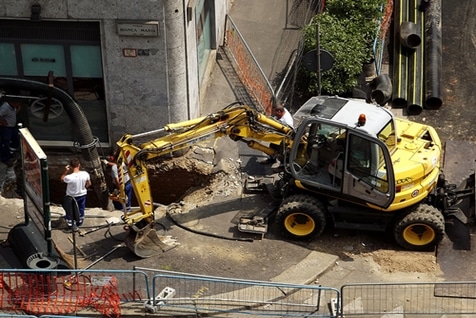Accidents at work are common events, but they are also avoidable. Even the more serious events, like falling objects, are easily preventable, with the right measures and checklists – as well as due care and attention – significantly reducing injury in the workplace.
Falling objects can seem funny when the object is a light cardboard box or some other relatively harmless object. But in many cases, the object causes injury to workers, and sometimes even fatalities.
Falling Objects Can Cause Major Problem
According to the latest Notified Fatalities Statistical Report from Safe Work Australia, the most common cause of fatality from July 1, 2010 to June 30, 2011 was ‘being hit by falling objects’, accounting for 26 of the 138 work-related deaths over the 12-month period.
And according to statistics published by Safe Work Australia in July 2012, injuries caused by ‘hitting, being hit by or being cut by an object’ accounted for the highest percentage of injuries incurred by male labourers (34%), community and personal service workers (34%) and technicians and trades workers (41%), and the second highest for male machinery operators and drivers (21%).
But these represent just a drop in the injury ocean, with figures showing more than 638,000 people experienced at least one work-related injury or illness for 12 months to June 2010.
The potential severity of injuries is dependant on the workplace itself:
- With construction sites having scaffolding, bricks and tools that can fall off work areas high up.
- Warehouses and yards can have over-crowded or unstable shelves from which items can fall.
- While offices can have shelves and storage units from which office supplies can fall.
Preventing accidents at work is paramount to establishing a safe working environment, and there are plenty of things that can be done to achieve this.
When it comes to lessening the risk of objects falling on staff, care and attention are the two main attributes that are required. But, through the relevant PCBU, checklists and measures should also be introduced to maintain safety standards.
Below, we provide selected extracts from the Falling Objects Fact Sheet [381KB] which has been published by Safe Work Australia.
You can find out more information by reading the complete fact sheet (click on link above), or by visiting the Safe Work Australia website.
Some Fact Sheet Facts
The Role of PCBUs
PCBUs must manage the risks associated with an object falling on a person if it is reasonably likely to injure the person.
Adequate protection must be provided to minimise the risk and protect the person.
When managing risks, the risk must be eliminated, so far as is reasonably practicable. If elimination is not reasonably practicable, the risks must be minimised so far as is reasonably practicable.
This requires each relevant PCBU to provide and maintain a safe system of work including:
- Fall prevention, so far as is reasonably practicable, and
- If fall prevention is not reasonably practicable—a system to arrest falling objects, so far as is reasonably practicable.
Other control measures can include:
- Use of ‘isolation’ or ‘no go’ zones where there is a risk of an object falling into an area
- Providing appropriate training and supervision
- Use of suitable Personal Protective Equipment (PPE)
Administrative controls (such as safe work methods or procedures) and PPE should only be used:
- When there are no other practical control measures available (as a last resort)
- As an interim measure until a more effective way of controlling the risk can be used
- To supplement higher level control measures (as a backup)
Further information and guidance on selecting appropriate control measures is available in the Code of Practice: How to Manage Work Health and Safety Risks [1.2MB].
Selecting Control Measures – Fall Prevention
Fall prevention must be considered and, so far as is reasonably practicable, implemented before considering options for arresting the fall of objects. Control measures that can assist in protecting persons from falling objects are suggested below.
Securing A Load
To prevent objects from falling freely from one level to another when they are being stored a secure physical barrier should be provided. Examples of additional control measures include:
- Stacking items so they cannot slide, fall or collapse when they are stored above ground level
- using netting or restraining bars to keep items in place when they are stored Ubove ground level so they cannot fall easily if they are disturbed
- Following the safe load limit of the storage system when storing items
- Ensuring shelving systems, barriers and other fittings are properly secured and well maintained
- Inspecting pallets each time before use to make sure they are in a safe condition
- Loading pallets correctly to ensure load stability – banding, shrink or stretch wrap can help with this.
Moving A Load
When moving a load, a safe means of raising and lowering plant, materials and debris should be provided. Examples of additional control measures include:
- Handling equipment such as a fork-lift truck that is suitable for the job is properly inspected, maintained and operated by competent and/or qualified persons as required
- Following the safe working load limits and taking into account all relevant factors such as stability of ground conditions, use of outriggers or stabilisers, slewing rate and wind conditions (if applicable)
- Making sure the load is balanced and secure when the load is lifted
- Enclosing areas that loads are being lifted over, and
- Establishing ‘isolation’ or ‘no-go’ zones with barriers and trained workers to restrict access
Working At A Height
Examples of controls for working at heights include:
- Keeping large equipment at ground level
- Good housekeeping, for example keeping the work area tidy and ensuring materials, debris, tools and equipment that are not being used are out of the way
- If placing an item on a scaffold or platform, providing a secure physical barrier at the edge of the elevated area, such as toe boards or infill panels that form part of a guardrail system
- Tethering or otherwise securing tools and materials to prevent them falling on people below
- Keeping tools or other materials away from edges and off of railings or sills
- Using chutes when placing debris into a skip below a work area.
Safety First
Alsco’s Managed Training Service is a complete solution that will compel action within your business. Our Training Guarantee ensures you manage your training costs irrespective of staff turnover. Understanding our customer’s needs identified a need not only for training courses but the ability to manage and maintain the total compliancy of certifications, and aspects of legislation over and above just training.
Talk to an Expert! Our representatives are waiting for your call.
Image courtesy: Franco


LEAVE A REPLY
Your email address will not be published. Required fields are marked *
You must be logged in to post a comment.